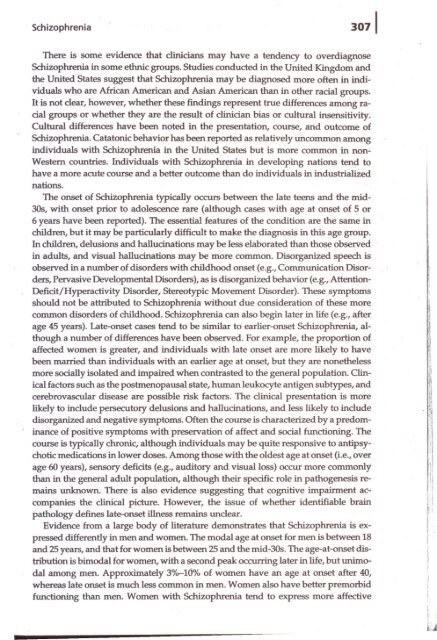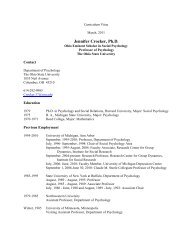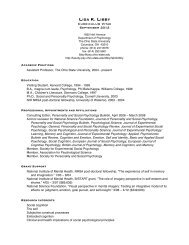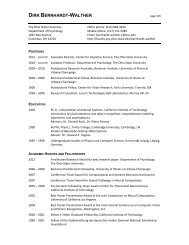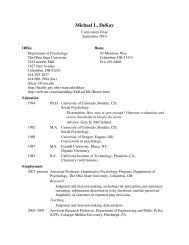Schizophrenia and Other Psychotic Disorders pg297-315.pdf
Schizophrenia and Other Psychotic Disorders pg297-315.pdf
Schizophrenia and Other Psychotic Disorders pg297-315.pdf
You also want an ePaper? Increase the reach of your titles
YUMPU automatically turns print PDFs into web optimized ePapers that Google loves.
<strong>Schizophrenia</strong><br />
There is some evidence that clinicians may have a tendency to overdiagnose<br />
<strong>Schizophrenia</strong> in some ethnic groups. Studies conducted in the United Kingdom <strong>and</strong><br />
the United States suggest that <strong>Schizophrenia</strong> may be diagnosed more often in individuals<br />
who are African American <strong>and</strong> Asian American than in other racial groups.<br />
It is not clear, however, whether these findings represent true differences among racial<br />
groups or whether they are the result of clinician bias or cultural insensitivity;<br />
Cultural differences have been noted in the presentation, course, <strong>and</strong> outcome of<br />
<strong>Schizophrenia</strong>. Catatonic behavior has been reported as relatively uncommon among<br />
individuals with <strong>Schizophrenia</strong> in the United States but is more common in non~<br />
Western countries. Individuals with <strong>Schizophrenia</strong> in developing nations tend to<br />
have a more acute course <strong>and</strong> a better outcome than do individuals in industrialized<br />
nations.<br />
The onset of <strong>Schizophrenia</strong> typically occurs between the late teens <strong>and</strong> the mid<br />
305, with onset prior to adolescence rare (although cases with age at onset of 5 or<br />
6 years have been reported). The essential features of the condition are the same in<br />
children, but it may be particularly difficult to make the diagnosis in this age group.<br />
In children, delusions <strong>and</strong> hallucinations may be less elaborated than those observed<br />
in adults, <strong>and</strong> visual hallucinations may be more common. Disorganized speech is<br />
observed in a number of disorders with childhood onset (e.g., Communication <strong>Disorders</strong>,<br />
Pervasive Developmental <strong>Disorders</strong>), as is disorganized behavior (e.g., Attention<br />
Deficit/Hyperactivity Disorder, Stereotypic Movement Disorder). These sYmptoms<br />
should not be attributed to <strong>Schizophrenia</strong> without due consideration of these more<br />
common disorders of childhood. <strong>Schizophrenia</strong> can also begin later in life (e.g., after<br />
age 45 years). Late-onset cases tend to be similar to earlier-onset <strong>Schizophrenia</strong>, although<br />
a number of differences have been observed. For example, the proportion of<br />
affected women is greater, <strong>and</strong> individuals with late onset are more likely to have<br />
been married than individuals with an earlier age at onset, but they are nonetheless<br />
more socially isolated <strong>and</strong> impaired when contrasted to the general population. Clin-:<br />
ical factors such as the postmenopausal state, human leukocyte antigen subtyPes, <strong>and</strong><br />
cerebrovascular disease are possible risk factors. The clinical presentation is more<br />
likely to include persecutory delusions <strong>and</strong> hallucinations, <strong>and</strong> less likely to include<br />
disorganized <strong>and</strong> negative symptoms. Often the course is characterized by a predominance<br />
of positive symptoms with preservation of affect <strong>and</strong> social functioning. The<br />
course is typically chronic, although individuals may be quite responsive to antipsychotic<br />
medications in lower doses. Among those with the oldest age at onset (Le., over<br />
age 60 years), sensory deficits (e.g., auditory <strong>and</strong> visual loss) occur more commonly<br />
than in the general adult population, although their specific role in pathogenesis remains<br />
unknown. There is also evidence suggesting that cognitive impairment ac~<br />
companies the clinical picture. However, the issue of whether identifiable brain<br />
pathology defines late-onset illness remains unclear.<br />
Evidence from a large body of literature demonstrates that <strong>Schizophrenia</strong> is expressed<br />
differently in men <strong>and</strong> women. The modal age at onset for men is between 18<br />
<strong>and</strong> 25 years, <strong>and</strong> that for women is between 25 <strong>and</strong> the mid-30s. The age-at-onset distribution<br />
is bimodal for women, with a second peak occurring later in life, but unimodal<br />
among men. Approximately 3%-lO% of women have an age at onset after 40,<br />
whereas late onset is much less common in men. Women also have better premorbid<br />
functioning than men. Women with <strong>Schizophrenia</strong> tend to express more affective


